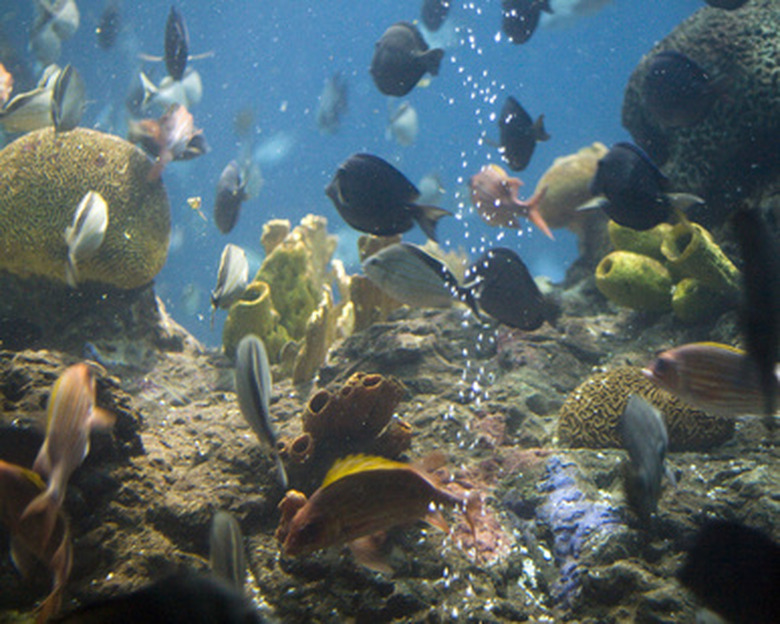Ecosystem Science Projects
Natural ecosystems on the earth are made up of plants, animals, air, land, and rocks. They consist of all the biotic and abiotic features in a particular area. These elements depend on each other.
Read more about the types of environmental ecosystems.
A biome is a world environment of plants and animals that adapt to the specific environment around them. There are several ecosystems in each biome. By studying the different biomes of the earth, you will learn how to design and construct an ecosystem for a science project.
Read more about the different biome types.
You could design an aquarium to represent the ocean biome, a terrarium to represent the rainforest biome, or a desert terrarium to represent the desert biome, for example. We're going to go over these and other hands on ecosystem activities and ecosystem project ideas in this post, so keep reading to learn more!
Study Biomes of the World
Study Biomes of the World
Study the biomes of the world by logging onto the World Biomes website and reviewing the features of the biomes around the world. Using paper and pencil, take notes on the features of these biomes.
Repeat this for all of the biomes, and ecosystems within those biomes, that interest you. Review the features of these specific biomes.
What are the plants, animals, insects, and rocks found in each environment? Write a detailed list. Also consider if water is present.
Design an Aquatic Ecosystem Diorama
Design an Aquatic Ecosystem Diorama
Using Internet resources, research what types of plants, fish, rocks, and coral make up a specific aquatic ecosystem that interests you. Write down all the elements needed to design the aquarium. Include the types of soil and depth, the number of plants and fish, the rocks, sand, coral, and type of aquarium needed for the project.
Then, using the Make an Aquarium link as a guide, design a unique fresh water or ocean aquarium. Supplies needed for the project can be purchased at local pet stores or retailers that specialize in fish. All of this information can be used to make an informative diorama as well.
Design a Rainforest Ecosystem Diorama
Design a Rainforest Ecosystem Diorama
Using Internet resources, research all the animals, plants, types of soil, and rocks you need to create a rainforest ecosystem. Sketch on paper a detailed plan of how the plants, animals, and soil will be arranged. Make of list of the number of plants and size needed, and what animals will fit into the terrarium.
Use the Magic Terrarium link to design your own unique rainforest ecosystem. Supplies can be found in nurseries, pet stores, and home improvement stores with garden centers. Some department stores carry simple containers for easy-to-make projects.
Design a Desert Ecosystem Diorama
Design a Desert Ecosystem Diorama
Using Internet resources, design on paper a detailed plan of how your desert aquarium will look. List the plants, types of soil and reptiles needed for the ecosystem. Draw a detailed sketch of where the soil, plants and small reptiles will go. Then, using the Build a Desert Ecosystem link, create your ecosystem. Supplies for desert terrariums can be found at pet stores, department stores, craft stores and garden centers.
Any of those dioramas are great hands on ecosystem activities that will teach you all about the specific area you choose. The best part is that if doing this for a class project, you can your classmates could pick the same type of biome but different specific ecosystems around the world and get completely different end projects.
Examine the Ecosystems Around You
Examine the Ecosystems Around You
You don't have to venture far away or even use the internet to have an ecosystem project. There are ecosystems all around us: in your backyard, the forest down the street, the beach, a marsh, etc.
Take a notebook and some binoculars and head out into an ecosystem in your area. Spend a few hours taking notes about what you see, hear, smell, etc. Write down animals you see, trees and plants in the area, the overall look of the ecosystem, etc.
Next, log onto the internet. Look up your area's average rainfall, temperatures, climate, etc. Using everything you gathered during the hands on ecosystem activities you've done so far, see if you can identify what type of biome and ecosystem you're in. This ecosystem project is almost like a mystery you need to solve with observations, data, and your own knowledge of ecosystems.
References
Cite This Article
MLA
Russell, Joan. "Ecosystem Science Projects" sciencing.com, https://www.sciencing.com/ecosystem-science-projects-5930956/. 22 November 2019.
APA
Russell, Joan. (2019, November 22). Ecosystem Science Projects. sciencing.com. Retrieved from https://www.sciencing.com/ecosystem-science-projects-5930956/
Chicago
Russell, Joan. Ecosystem Science Projects last modified August 30, 2022. https://www.sciencing.com/ecosystem-science-projects-5930956/
